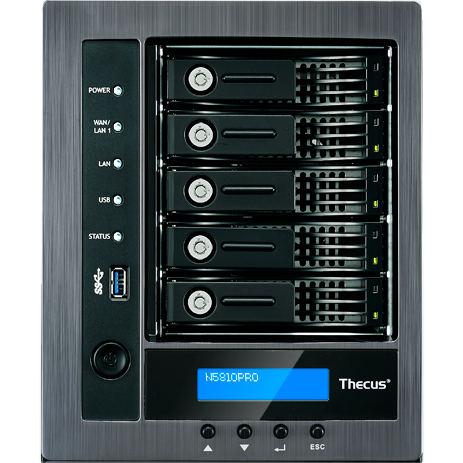Asustor AS6204T NAS Review
Why you can trust Tom's Hardware
Four-Corner Performance Testing
Product Comparison
Sequential Read Performance



Although Asustor products typically perform well in our tests, we ran into an issue with the AS6204T right out of the gate. We took our results to company representatives and had a new firmware one week later. The initial release suffered low sequential write performance at low queue depths. Asustor tells us the workload was so light at a queue depth of one that the system didn't enable Turbo Boost. Instead, it remained in a low-power state. The update fixed the issue, and is now publicly available.
Reading 128KB blocks happens a little slower than on some competing platforms, which is surprising for Asustor. Sequential benchmarks run using different block sizes look better, at least.
Sequential Write Performance
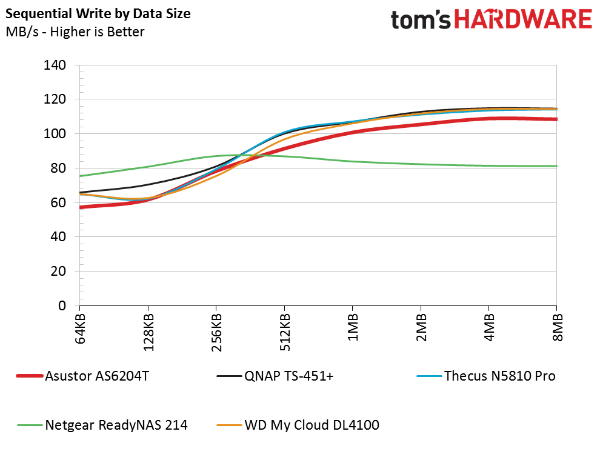
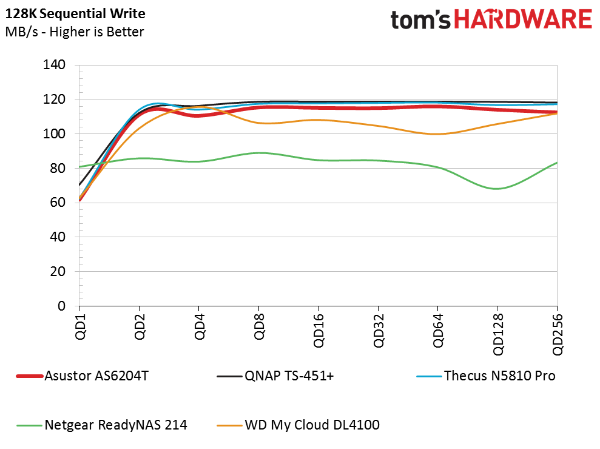

The sequential write tests are kinder to Asustor, though again the AS6204T encounters lower performance when it's faced with certain block sizes compared to other NAS appliances. Though the difference is small, we'll be keeping an eye out for correlation during the real-world tests.
Sequential Mixed Workload Sweeps




These results show how mixing reads and writes affects transfer performance. In a home environment, you might occasionally send and receive files at the same time. That happens a lot more often in an office. It's important that you buy the appliance that best matches your demands, and our mixed workload benchmarks help guide your decision.
Random Read Performance



You'll typically only encounter small blocks of data accessed randomly when you run software that uses the NAS as central storage. Examples include virtual environments like Hyper-V and ESXi (the former is optimized for 4KB blocks, while the latter is optimized for 8KB blocks). Other popular office applications, such as QuickBooks, use 4KB when run from a Windows environment.
Random Write Performance



Many of the random write tests look like waves as we move across queue depths. This is caused by the system cache when it flushes during our benchmark. We've increased the test duration, but the only way to completely remove those peaks and valleys is running each NAS in steady state. Although that'd help mask the cache's impact, we'd also veer further from reality. After all, NAS systems aren't subjected to the same taxing workloads encountered in the enterprise.
Asustor's products have always employed a lot of cache to improve random performance. NAS manufacturers can optimize this parameter from within the embedded Linux operating system. The AS6204T with 4GB of RAM doesn't excel in these charts as much as models that ship with 8GB of system memory, though.
Get Tom's Hardware's best news and in-depth reviews, straight to your inbox.
Random Mixed Workload Sweeps

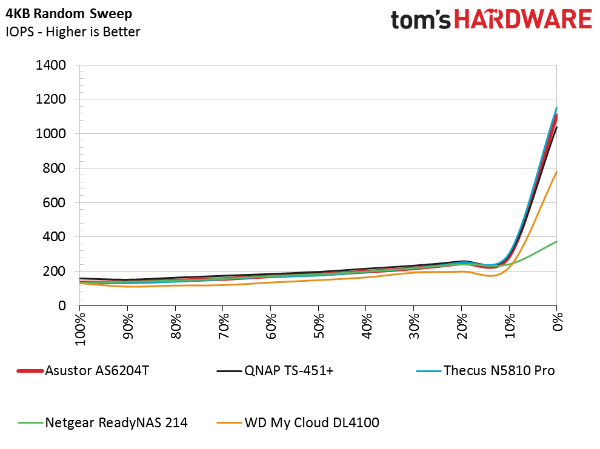

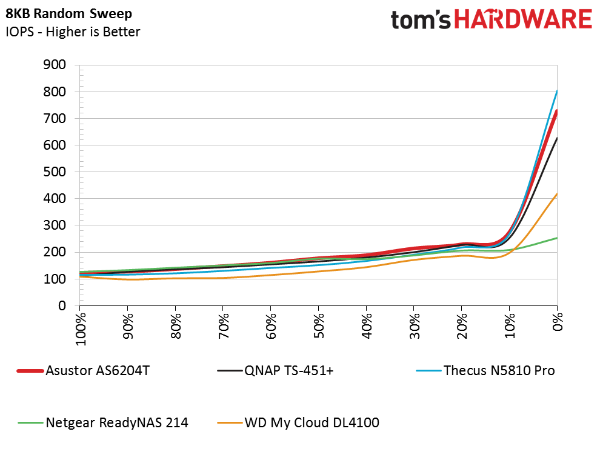
The effect of caching is obvious when you look at the sweeps across our random mixed workloads. When we hit 100 percent writes, performance spikes as the RAM absorbs incoming data. That steady build-up you see from 100 percent read to 100 percent writes happens when the cache steps in the help the slower hard drives.
Encryption Performance




In addition to our usual benchmarks, we also wanted to test with encrypted folders to see how Intel's Braswell-based SoC works with AES-NI active. In the tests above, we compare iSCSI and SMB transfers to SMB with encryption enabled.
Using encryption still imparts a performance penalty, but it's smaller here than on appliances without AES-NI. Previously, we saw encryption cut performance in half (or worse). That no longer has to be the case.
Current page: Four-Corner Performance Testing
Prev Page A Closer Look Next Page SMB, iSCSI And Standard Server Workloads
Chris Ramseyer was a senior contributing editor for Tom's Hardware. He tested and reviewed consumer storage.
-
JQB45 I wish they would just sell the case in mITX size. Then I could add more own OS and other hardware.Reply
-
littleleo I have the ASUSTOR AS-202TE hooked to my living room TV. Some of the apps are just not functioning as promised but for what I paid it was a good deal.Reply -
CRamseyer 8GB max for the system memory. The limitation is from Intel on this processor / chipset.Reply -
HideOut Again, just get a Buffalo 441e and put your own drives in it. It's not as fact, but its about $190 for the system + whatever 4 drives you use.Reply -
Xajel I'm looking for a 4-bay NAS, it will be my first one.. but I need three more features: Link Aggregation, Upgradable RAM & Visualization.. I know there's multiple options including this I'm not in hurry for the matter.. but why do you guys make a comparison table in each review...Reply -
DaDude1 ReplyI wish they would just sell the case in mITX size. Then I could add more own OS and other hardware.
There are cases like this available. I looked at them a few month ago (approx. $180 for 5 bays), but finally settled on a node304 (6 internal bays) for my home server. I got the case for $50 (on sale on newegg), added the ASROCK H97 ITX with WLAN ($50 on sale), Celeron G3258 ($44) and CX430 powersupply ($10 after sale and rebate). The memory I used from my desktop (had 32 GB, so removed 16GB and added into the server) and I had as well 4 x 3TB WD Green in my desktop, which I added to the server (plus an old 120GB SSD as boot drive). I added as well a 8TB Seagate external ($200 on sale) and a 5TB Seagate external (paid $120 a while back) via USB3 for backups of the system. Got Windows 2012 R2 DataCenter from Microsoft (free educational license). Running right now on the box Home NAS, MediaConverter, Linux VM (OwnCloud), MSSQL VM, Windows Access Server VM and Windows Remote App/Desktop VM. I have approx. 7 GB Memory free on the box, which leaves plenty for additional VM's. The only disappointing aspect of this HomeNas/Server build is MS Storage Spaces or more specifically it's implementation of RAID5. I get with mirrored drives plenty of throughput, but writing to a RAID5 volume is running between 25 and 30 MB/s after the cache is used up. So when I transfer large volumes of data (some Datasets I use for analysis are in excess of 1TB), take forever to transfer to the volume. Overall the box cost me approx. $250 (excluding harddrives) and I take this anytime over any of the NAS boxes. I tried some of the NAS boxes (QNAP, Synology) and was very disappointed. If you have a bit of time (took me approx. 1 hour to build and approx. 6 hours to install and configure Windows 2012 R2) this would certainly be a better choice.
Getting back to cases look at the following:
Silverstone DS380 (8 hot-swap plus 4 x 2.5 internal) for $160
I believe Startech USA had a case that looked like the Asus or QNAP 4 bay units for approx. $180.
-
JQB45 @DaDude1 - I like the SilverStone DS380B you mentioned.Reply
Here is a custom build using the SilverStone DS380B that costs less then a Diskless Asustor AS6204T NAS
PCPartPicker part list / Price breakdown by merchant
CPU: Intel Pentium G4400 3.3GHz Dual-Core Processor ($59.99 @ SuperBiiz)
Motherboard: ASRock H110M-ITX/ac Mini ITX LGA1151 Motherboard ($67.99 @ SuperBiiz)
Memory: Kingston Savage 8GB (2 x 4GB) DDR4-2400 Memory ($49.99 @ Newegg)
Storage: Samsung 850 EVO-Series 500GB 2.5" Solid State Drive ($149.45 @ OutletPC)
Case: Silverstone DS380B Mini ITX Tower Case ($144.98 @ Newegg)
Power Supply: SeaSonic 300W 80+ Certified SFX Power Supply ($39.99 @ SuperBiiz)
Other: Linux - CentOS ($0.00)
Total: $512.39
Prices include shipping, taxes, and discounts when availableGenerated by PCPartPicker 2016-04-17 05:11 EDT-0400
All thats left to add is the hard drives. -
CRamseyer Great, so who do you call for support if something doesn't work right? Also, Linux isn't exactly user friendly for people coming from Windows. You are comparing apples to oranges here.Reply

